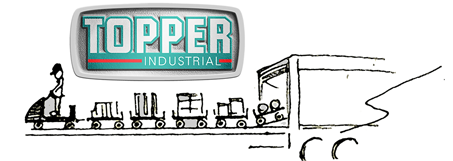A new distribution center (DC) is opening at a rate of 1 per day in 2018 and will continue throughout 2022 according to Area Development magazine. It is not simple to critically consider all the variables of planning a new DC.
Topper Industrial has identified the most important factors in designing a new warehouse that leads with the FTF (Fork Truck Free) movement. Fork trucks have been the backbone of warehouses since the 1940s. They take up large amounts of space. With SKU growth, often called SKU proliferation, companies fail to consider all the changes in the business when planning layout design and material flow.
More often fulfillment centers discover they may require space such as kitting, or product is better at line-side or is simply not able to be conveyed. More SKUs means a different cubic dimension than the current product mix which may be larger, smaller, heavier, longer, wider, and better handled via cart delivery.
Topper Industrial takes these factors into consideration when developing equipment as a result of warehouse planning, specifically calculating the number of pallet positions and forward pick locations that are able to be utilized by cart delivery. Topper Industrial has found that bottom-line impacts of fulfillment cost reduction drives productivity improvement.

Better material flow at a DC means better management of inventory. Too many falsely succumb to the idea that more storage space is needed to house ineffective inventory. Material flow in the FTF environment demonstrates sufficient key performance indicators (KPIs) to support accurate, lean, and predictive inventory reporting eliminating excess stock-on-hand. Topper Industrial quantifies an efficient business with less than one percent of excess inventory dollars. The DC industry standard is seven percent of inventory dollars deemed excessive. Sadly, wasted inventory dollars in the warehouse leads to inefficiencies.
All of this leads to the warehouse layout for the space in terms of work and product flow. Industrial carts directly impact inbound receiving, quality assurance, staging, returns processing, and forward pick configuration for the shortest pick path. Walk time, or back and forth fork truck deliveries are huge waste. New functions in the warehouse such as kitting or value-added services allow DCs, 3PLs, and fulfillment centers to review warehouse layout and process.

While selecting the right warehouse has long term throughput, productivity, and efficiency, companies overlook the best-practice opportunities when estimating the required distribution center space. While challenging in an existing building, one should not ignore these considerations. When purchasing a new building get the line-side delivery solution requiring the least space.
About Topper Industrial
For more than twenty years, Topper Industrial, (www.topperindustrial.com) based just outside of Milwaukee, WI, has been a leader in the material handling equipment industry. The company’s product roster features industrial carts, conveyors, lifts, lifts & tilts, shipping racks, containers, casters, and cart components. From mother-daughter carts to quad steer carts to tilt carts and rotate carts, Topper’s material handling solutions make delivering material line side more effective through more efficient practices. Topper Industrial has a team of experienced professional experts able to assess and provide the right product for all material handling equipment requirements.
Topper Industrial is a proud member of MHI. Follow on Twitter @TopperInd or on LinkedIn.

